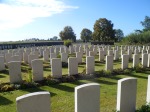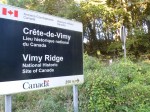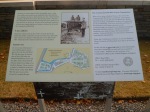A PILGRIMAGE OF WAR AND WORDS
Based on 3 walks (with books to follow) to commemorate the hundredth anniversary of the First World War, this first expedition starts at the Menin Gate and continues through Northern France to Nantes. The effort supports Cornwall Hospice Care and Prostate Cancer – ‘MOVEMBER’. See justgiving pages to sponsor Robin; you can also visit the Coppice Inn, Lanner to support Cornwall Hospice Care or The Rose & Crown, Oundle to be part of the MOVEMBER Challenge where either Robin or Ned will sign you up to grow a moustache for Prostate Cancer.
WALKING THE WAR GRAVES OF FLANDERS AND NORTHERN FRANCE
PHASE 1 YPRES TO AMIENS (THE FIRST WORLD WAR)
DAY 1 – 5KM TOUR OF YPRES
Arriving at the Menin Gate was a memorable occasion in itself and having set up camp nearby, I was able to attend the last post ceremony which is conducted each night before dusk. It is always a poignant affair commemorating so many lives lost in the battle for freedom and their names inscribed inside this huge monument convey the cost of history’s most horrific war. The Great War should never be forgotten for in this field of conflict have been so many sacrifices.
‘Over the top we go my friend,
To face bullet and barbed wire to our final end,
With only moments to live we struggle through the mud,
Into the darkness of battle, gun fire and blood.’
DAY 2. YPRES TO LILLE – 35KM
I began this first pilgrimage from the Mennin Gate with thoughts of those less fortunate to have visited this little place nearly a hundred years ago. I hoped to take many photographs and write up my experiences on the road and note in particular any of the great battlefields I will see over the 3 walks I will do between now and 2014. Not far from town is Bedford House Cemetery where the strongest words of war are found on the epitaphs of the dead buried in a formation of white tombstones that spread for acres each side of a nearby stream. A touring party gathered close by as I perused a few rows looking for long lost relatives; it was a hopeless task as one could easily spend a week out here in search of a relative – many of the sections were simply listed as ‘Unknown Soldier’ and the regiments that served here were innumerable. In fact the whole stretch between here and Lille was interspersed with graveyards built literally where men from Britain and the Commonwealth had fallen in battle. The whole episode was poignant and humbling to walk among such bravery and sacrifice which is largely unimaginable in today’s world. These days people seem more stressed about second homes, cars and 100,000k bonuses to pay for it all. Many know not of the suffering of these great men whose epitaphs will remain iconic in these parts until the world’s end.
Crossing the border into France about 2pm, the passage gradually became more urbanised taking in a riverside stretch on the outskirts of Lille. After a walk through the town I was offered a room at the Hotel De la Treille (normally 185eu per night) for 41eu by the manager which I gratefully took and after 2 beers, bread and cheese retired to bed.
DAY 3. LILLE TO VIMY RIDGE – 40KM
Bidding goodbye to my hosts after a wonderful stay, I took the cultural route to the edge of the city where I continued my journey along the D925. Magnificent architecture and village war memorials were the dominant features of today’s journey as passed through Watignies, Seclin, Carvin and Lens where I sampled ‘café au lait’ in the sun outside a local restaurant. Feeling indecisive about which direction to take from here, an old gentleman crossed the road to offer advice. Following his instructions I was able to progress along an old road to Eleu and eventually Vimy where I stopped a shop to obtain groceries for the next two days. The main road continues through the ridge which is surrounded by timber fencing. It was near here that the Canadians fought a great battle during WW1. Locating an entrance to the forest marked by a Maple leaf, I entered and camped nearby that evening enjoying the peace and solitude the location offered.
DAY 4. VIMY RIDGE TO WARLINCOURT LES PAS – 45KM
Rising at 7am allowed ample time to decamp and explore the area which has been designated as a national park in honour of the Canadians who fought here; beyond the area is a cemetery where the men fell in battle. There were many more of these along the way as my journey continued first to the lively town of Arras and then along a cycle route which showed insight into the quieter rural areas. Arras was steeped in ancient architecture with a plaza/citadel area reminiscent of Santiago in Spain. There was the usual confusion of finding an exit and I did not join my planned route though the cycle route proved invaluable allowing me safe passage as far l’Arbert. After a short blast along the main route I was able to turn off and follow the route to Pas-en-Artois where I found a camp site at Warlincourt les Pas.
DAY 5. WARLINCOURT LES PAS TO AMIENS – 40KM
The weather remained sunny – cool at night but pleasantly warm in the day reaching a top temp of about 17c. I had washed some socks and a shirt at the camp site the previous evening and they were drying out nicely on the back of my rucksack as I neared Pas-en-Artois. After a coffee at Pas-en-Artois, I began my trek through the Somme Region which was another important battle front during the Great War; those that fought here as with Ypres knew suffering beyond imagination. During the initial offensive in 1916, 20,000 men fell in the first hour of the campaign which by the end of the war had accounted for more than 600,000 casualties.
There were many memorials along the way and a few broken areas which resembled partial trenches now flanked by evergreens interspersed across miles of arable land. During the time of the war the landscape along the Somme River would have been unrecognisable as men sheltered in trenches from the barrage of shrapnel that left behind churned up mud, barbed wire and broken spirit. Today the forests look green enjoying the fertile terrain and I was amazed to find that many of the crops were yet to be harvested.
Passing a farm I saw a litter of cats learning their apprenticeship in the waste ground nearby. As I neared Amiens the traffic intensified and I had to ensure I got onto the correct route into the town. I saw no sign of the military HQ of the Somme Campaign; only a hospice building resembled anything that may have survived that era. It was quite pleasant down by the river and after collecting a few groceries I continued away from the place using a minor road which at least ensured me an opportunity to camp at one of the smaller villages. I managed to find a forest/park area around dusk and set up camp beside a small stream; apart from the furore of squabbling ducks, it was peaceful enough to ensure I had a few hours of quality sleep.
PHASE 2 AMIENS TO LE MANS
DAY 6. AMIENS TO MARSEILLE EN-BEAUVAIS – 50KM
Waking in a downpour I hastily packed my kit and headed off in the direction of Conty – roughly 14km.
I passed many villages and it wasn’t until I reached Conty that I realised I was on the wrong road!! It hardly mattered except for 3km excursion west to pick up my planned route to Crevecoeur-le-Grand. As it turned out it was even quieter than the last road journey as I headed away from the Somme Valley and relics of the Great War. Although Normandy had seen its share of conflict in the Second World War, today was celebrated by the rural composure of this beautiful countryside. So quiet were the villages I passed through that I did not even find a shop or anything that resembled a contemporary facility.
Eventually I arrived at Crevecoeur and was able to obtain water and food. It was after 5pm but I still managed to cover a further 10km to Marselle en-Beauvais and camped at dusk in a coppice by a ploughed field above the town. I sat for a while and watched the day draw to a close – the world seemed at peace here and so was I.
DAY 7. MARSELLE –EN-BEAUVAIS TO LES ANDELYS – 60KM
There was light rain during the night and it felt a few degrees warmer so I did not need to use my bivvy bag. Leaving at dawn in windy wet conditions, I was unable to obtain water for the first 10km. I had to go off course into a tourist village where I got water from the tourist office and later a coffee at a craft shop. Here I enthused about my experience of walking Europe and that so far I had made good progress on this trip. I continued in the rain stopping for more coffee and provisions at Gournay-en-Bray.
Pressing on in heavy rain I encountered farm machinery and speeding lorries which seemed to gather momentum in inclement weather. The conditions did not ameliorate and around 5pm I stopped at a small village for raisin bread and coffee. After photographing the cenotaph and church, I continued my journey towards Les Andelys which was a further 18km. Wet weather prevailed all day flooding the narrow road as darkness fell. By now I was at the mercy of speeding traffic with little en route other than the usual benign villages that would harbour no shelter or facilities. Finally at 9pm I entered the town of Les Andelys where I got a hotel room for 60 euros; later I managed to feed myself at a Chinese Restaurant on the buffet menu and after washing my wet clothes I fell into a deep sleep brought on through sheer exhaustion.
DAY 8. LES ANDELYS TO ST SEBASTIAN – 40KM
It was a relief to find refuge last night and I was also able to enjoy both an evening meal and breakfast for once. Walking in clean dry kit also put a spring in my step as I gathered pace throughout the first 10km to Gaillon. After coffee I managed another 15km to Evrioux where I gathered provisions for the night. Owing to a later start it was dark by the time I reached St Sebastian and so pitched a tent just a few km beyond the town at a small village park.
DAY 9. ST SEBASTIAN TO L’AIGLE – 56KM
Rising at 6am I was greeted with wet, windy conditions which prevailed initially though by the time I reached the lovely town of Condes (16km) the sun was shining I spent my meal break at the castle ruin. Nearby was a lovely slim-spire church; though the villages portray a quieter version of life compared to the larger towns, they abound with character hallmarked by Gothic-style buildings Norman churches and elegant bell towers. There was also a great sense of rural isolation about the journey occasionally broken by forests frequented by deer and red squirrels. There was a dead adder lying in the roadside and some huge toads which had also been crushed by the speeding traffic. I stopped at La Neuve-Lyre around 5.30pm and a further 12km saw at L’Aigle where I did my shopping. On locating my next route at the end of town I pitched camp on the rough ground above the carriageway.
DAY 10. L’AIGLE TO BELLAME – 50KM
Decamping at 7am, saturated in dew, I made my way through the rural countryside along the quieter D930 as far as the next town (10km) Les Apres where I stopped for coffee.
By midday the cloud cover turned to drizzle which was set for the duration of the outing. The slow hack took in a large expanse of forest broken by diminutive communities culminating at Mortagne Au Perche at 3pm – 30km completed.
From here I embarked on the last stage of phase 2 to Le Mans.
The rain grew heavy – not boding well for camping tonight; I had one further coffee break before completing the last 10km to Bellame where the local grocer was very kind and helpful. She warmed me up with a drink and contacted the local priest to help find me a place to stay. He turned about 9pm and took me to a small shelter which is used for homeless people a few meters from the shop. Here I welcomed the use of a shower and a bed for the night thanks to the kindness of these people whom I’d only just met.
DAY 11. BELLAME TO LE MANS – 54KM
Rising early I set off from the shelter around 8am, taking a few photos before leaving town. At least I had a dry start though my kit was wet and my knee hurt due to the extra weight of my rucksack– about 70lbs in all.
8km into the day I stopped for coffee at a village called Ige. From here I pressed on to a supermarket where I brought my lunch and chatted with the young maid who was actually fluent in English. Whilst I was eating my food the shop closed and the maid came over to wish me well as I went on to explain that I would be walking the rest of Northern France. An 11km walk saw me arrive at Bonne Table – by now I was 30km from Le Mans. The afternoon passed quickly and the weather stayed warm though there was a build up of traffic 10km from Le Mans. Unable to find any facilities I pressed on into town where eventually I found a bar that was still open on a Sunday. Here the locals welcomed me and praised my efforts. The landlady brought over meat and bread and the girls I met bought me drinks. Later one lady called Laelilia showed me where to camp and gave me her address so that I could get a shower and breakfast in the morning – all in all it was a good end to the day.
PHASE 3 LE MANS TO NANTES (NORTHERN FRANCE BORDER)
DAY 12. LE MANS TO MAILCOMBE – 35KM
Having poured of rain all night I managed to pack my gear and tent quickly and then find my friend’s flat where I enjoyed a shower and breakfast whilst she dried some of my clothes. Bading farewell about 10pm I encountered road repairs; most people I had spoken to here lived in fear of the Taliban though this place seemed more under siege of a JCB as the whole town centre had been decimated by road works. On leaving Le Mans I faced heavy rain throughout the day which was also the forecast for the week. It was hard to keep going and I made more than the usual stops to get me to reach La Suze and Mailcombe where on finding a reasonable hotel opted to stay the night. I welcomed the comfort of a room and a chance to dry out my gear, which had become increasingly heavy due to inclement weather. Just as I had called it a day down came a huge storm which justified my decision to stop at the inn.
DAY 13. MAILCOMBE TO ANGERS – 60KM
A good night’s rest gave me strength and with a dry start I made light work of the D23 to Durtal covering 25km by 1.30pm. I now had to make the decision on which route to take to Nantes which was about another 150km.
Traffic died down in the afternoon due to a road works which completely blocked off the next town; it would seem that maintenance here is a serious business leaving the thoroughfare barely passable with no access to shops/restaurants nearby. Later I passed over the River Loire for the first time admiring the views of mill and waterfalls on the left. It was a huge boost as the Loire is a natural border of Northern France and a reminder that the end of the journey was now in sight. From Seiches Le Loir I would power my way through the final outposts of this epic journey heading first for Angers; then a 100km stretch along the main carriageway by the river to Nantes.
It was a great effort and I gave my all as I reached Angers by nightfall – the last big town before Nantes which I hoped to reach sometime on Thursday.
By the time I reached the top of town I found a Pension and decided to stay there for 40eu including breakfast rather than camping.
DAY 14/15 ANGERS TO NANTES – 100KM
Having enjoyed a good night’s rest I indulged in a nourishing breakfast leaving the pension around 7am – still dark. I was soon perplexed by the intricate motorway system and had difficulty getting on to a pedestrian route. Having stopped at a few hotels to obtain instructions on how to escape this place, I managed to follow a country lane which took me to St Jean De Lineare. It was a bit of a lottery getting there as the penultimate junction wasn’t sign posted; thankfully turning right led me to the correct destination.
After a much needed coffee I joined the D723 to St Georges s-Loire (11km) with Nantes registering a further 79km.
After some drizzle it brightened up and I made the most of the little towns along the way stopping at St Georges and Capogiate with its castle ruin. Entering a café I met a mad woman who kept pestering me and trying to get drinks of customers as they came through the door; none of them stayed long! Worse still she spoke fluent English and started ranting at me and mocking my efforts for charity. Even after I left she pursued me in a car despite having downed a good volume of wine whilst at the café.
The whole affair was quite unsettling as I tried to concentrate along the busy road. Wet weather came and so did the blisters as I wore down my training shoes to bare rubber. I eventually resorted to wearing size 9 walking shoes – ouch!! These really pinched my heels – all the walking had made my feet swell to size 10 which is my usual expedition shoe size.
By 6pm I had completed 50km taking in Ingrandes and Varades with Nantes another 40 plus left to walk. After a coffee I soldered on to the last main town en route called Alcenes which was slightly west of the D723 on the River Loire. As dusk drew near I struggled to find a route out of the town and after consulted a maid at an inn I continued along a subsidiary road which eventually rejoined the D723. The walk became intense in the pitch black and pouring rain and at the next town junction, 29km from Nantes, I felt that I was too sore to continue efficiently. In desperation I tried to put up a tent in the dark. The ground was hard and I was unable to drive the pegs in sufficiently and so just made a temporary shelter where I rested for a couple of hours from a relentless storm. Unable to sleep I dismantled the shelter as soon as the rain stopped and continued walking in the dark. The respite was only a short one and as the storm recommenced so did the build up traffic. It was like walking up a stream at times and the speeding trucks made the journey a hazardous one. As the menacing trucks rolled by, in the distance there were lightning flashes as thunder roared across the sky. Eventually daylight began to emerge from the heavy clouds and on finding a café on the outskirts of town I stopped for a drink and chat to the owners who told me the train station was a further 10km. It was a difficult passage in the side of the road and I stopped once more for a breakfast at Macdonalds. From here I gradually made my way to the train station to conclude my walk and after the monumental effort from the previous day I was glad to obtain a bit of food and a comfort as I began the journey back home. From Nantes Gare I was able to get a train to Rennes; a second one to Morlaix where a bus took me to the town of Roscoff where I awaited the ferry service back to Plymouth. I had missed today’s voyage and therefore booked into a hotel for the night. Roscoff was a lovely place which I would hope to visit again in the Spring when walking the Bordeaux section from Biarritz. Now was the end of season and it was pleasantly quiet as a young maid at the hotel made me welcome and helped with important information. After enjoying a sunny morning by the harbour I made my way to the terminal where I boarded the ferry to Plymouth around 1600 hours. Arrival in Redruth was not until after midnight.
The whole effort was something of an epic, starting at the Menin Gate in the shadow of World War 1 and finishing along the Loire in Northern France.
At this stage I’d like to appeal to the public to make an effort to support either of my chosen charities by making a donation to my justgiving pages featured on the website. You can also make donations at the inns mentioned on our newsletters.
FUTURE PILGRIMAGES OF WAR
WALK 2 – 2013 – GERMANY/HOLLAND TO THE MENIN GATE
WALK 3 – 2014 – BASEL TO THE MENIN GATE
CHEQUE PRESENTATION – SUE RYDER (NOVEMBER)
PROSTATE CANCER (DECEMBER)
CORNWALL HOSPICE CARE (2013)
NEXT EVENT
WALKING NEW ZEALAND 2013.
Itinerary to be scheduled soon….







